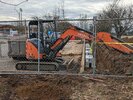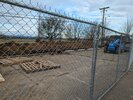M
Welcome to Tesla Motors Club
Discuss Tesla's Model S, Model 3, Model X, Model Y, Cybertruck, Roadster and More.
Register
Install the app
How to install the app on iOS
You can install our site as a web app on your iOS device by utilizing the Add to Home Screen feature in Safari. Please see this thread for more details on this.
Note: This feature may not be available in some browsers.
-
Want to remove ads? Register an account and login to see fewer ads, and become a Supporting Member to remove almost all ads.
You are using an out of date browser. It may not display this or other websites correctly.
You should upgrade or use an alternative browser.
You should upgrade or use an alternative browser.
Supercharger - Ridgefield, WA (LIVE May 2023, 12 V3 stalls)
- Thread starter MarcoRP
- Start date
-
- Tags
- supercharger washington
DeusExMachinist
Member
TunaBug
Member
IANAL, but after scanning that contract I think that section 16 means that Tesla does not pay anything for this. Or, to be clear, Tesla does not pay anything to the city for what they're leasing from the city. Tesla only pays construction, permitting, and utility costs. Is that common?
For supercharger locations on city property, it's fairly common. Some cities negotiate for Tesla to pay rent for the lease, some don't. Depends on a number of things, including how forceful/desparate Tesla's interest in the location is, etc. Note that in this case, in addition to the superchargers for Tesla vehicles to use, Tesla is also providing and installing two J1772 L2 stations for the city as part of the agreement. Otherwise, the value that the city is getting from Tesla is, "provision of electric vehicle charging services at the Property, will provide value to [the city] by attracting electric vehicle drivers to the Property."IANAL, but after scanning that contract I think that section 16 means that Tesla does not pay anything for this. Or, to be clear, Tesla does not pay anything to the city for what they're leasing from the city. Tesla only pays construction, permitting, and utility costs. Is that common?
TunaBug
Member
For supercharger locations on city property, it's fairly common. Some cities negotiate for Tesla to pay rent for the lease, some don't. Depends on a number of things, including how forceful/desparate Tesla's interest in the location is, etc. Note that in this case, in addition to the superchargers for Tesla vehicles to use, Tesla is also providing and installing two J1772 L2 stations for the city as part of the agreement. Otherwise, the value that the city is getting from Tesla is, "provision of electric vehicle charging services at the Property, will provide value to [the city] by attracting electric vehicle drivers to the Property."
That's interesting, thank you.
What do city councils see as the value of attracting electric car drivers? Personally, my use of park-and-rides is for multiple hours at a time, and I certainly would not connect to a supercharger for that time for fear of idle fees. If I were to go there specifically for L3 charging I would remain on site, not use a bus, and that bit of "attracting vehicle drivers to the Property" provides no value to the city. So I have to wonder if I'm missing something or if the city councils are missing something (both are likely).
The J1772 chargers are, of course, just cheap trinkets. However, even as a Tesla owner, I would find the J1772 more compatible with my use case than the L3 chargers.
acarney
Active Member
Well, you could use the park and ride and charge once a week for 25 minutes or something before heading home if you didn’t have home charging for some reason.That's interesting, thank you.
What do city councils see as the value of attracting electric car drivers? Personally, my use of park-and-rides is for multiple hours at a time, and I certainly would not connect to a supercharger for that time for fear of idle fees. If I were to go there specifically for L3 charging I would remain on site, not use a bus, and that bit of "attracting vehicle drivers to the Property" provides no value to the city. So I have to wonder if I'm missing something or if the city councils are missing something (both are likely).
The J1772 chargers are, of course, just cheap trinkets. However, even as a Tesla owner, I would find the J1772 more compatible with my use case than the L3 chargers.
Otherwise I suspect it was just a location the city had extra space to give up that was near a highway.
Having local superchargers can attract more people buying Tesla’s, even if they don’t intend to use the supercharger all the time. I makes it more visible for people, might allow some impromptu conversations, gives a reassuring feeling that if you can’t charge at home (apartment, condo, move, etc) that you always have that quick charge backup near you, etc.
Cities might also look at it as a way to “get out of” paying for their own charging infrastructure. If they do a comprehensive study in a year or two on how much charging they need to build, a supercharger might remove A LOT of the needed capacity, even if it would be far more convenient to have 500 level 2s amongst the city (think every grocery store having 10 to 12, the mall, apartments complexes, etc).
I sort of hate that level of thinking with a city because a 25-35 minute charge stop is NOT the same as 5 minutes or less getting gas. There should still be a huge focus on being able to plug in everywhere you shop, run errands, or go out to eat or watch a movie. I would much rather have the ability to grab 5-10 kWh every time I go shopping than sit in an empty parking lot for 30+ minutes every 7 days. I get the feeling when quick chargers show up in a city they go “Look! Task complete!” and then watch as non-Tesla quick chargers sit empty most the time.
Toss a few level 2s at the movie theater, hospital, mall, and grocery store and I notice them getting used WAY more.
erikjohns
2020 Model 3 SR+ | 2022 Model Y LR
Ridgefield just announced that there will be a Costco going in, just on the other side of I-5 from this location, about a half a mile away. Might make this Supercharger more popular than the one in Salmon Creek.
Pre-Application Submitted for a Costco Retail Warehouse in Ridgefield, Washington - City of Ridgefield
Pre-Application Submitted for a Costco Retail Warehouse in Ridgefield, Washington - City of Ridgefield
floatplane
Member
The agreement says Tesla can’t ”occupy” the site (start construction) before March 2023.
since all our family trips to Oregon require a stop at Burgerville, we’ll be skipping Ridgefield when it’s built, and will go to the Vancouver V2 charger instead, despite that needing more off-highway maneuvering (BV drive-thru first, then SC) and slower charge rate.
Given that V3 units begin to taper after 5 minutes typically, the V2s aren’t much slower in total time if you can avoid the shared service. Frankly I’m beginning to appreciate a longer meal break while charging at a V2 stall than the V3s allow, especially if there’s a few minutes walk to a decent/favorite restaurant. If idol fees were only imposed during congested periods, I could stop charging to 100% if I want to spend 40 minutes or more out of the car.
since all our family trips to Oregon require a stop at Burgerville, we’ll be skipping Ridgefield when it’s built, and will go to the Vancouver V2 charger instead, despite that needing more off-highway maneuvering (BV drive-thru first, then SC) and slower charge rate.
Given that V3 units begin to taper after 5 minutes typically, the V2s aren’t much slower in total time if you can avoid the shared service. Frankly I’m beginning to appreciate a longer meal break while charging at a V2 stall than the V3s allow, especially if there’s a few minutes walk to a decent/favorite restaurant. If idol fees were only imposed during congested periods, I could stop charging to 100% if I want to spend 40 minutes or more out of the car.
acarney
Active Member
The point in the taper where you equal the speed of a V2 is probably around 50% SOC, so if you plug in at like 15%, you're getting ~26kWh at a speed faster than a V2 station can do max...The agreement says Tesla can’t ”occupy” the site (start construction) before March 2023.
since all our family trips to Oregon require a stop at Burgerville, we’ll be skipping Ridgefield when it’s built, and will go to the Vancouver V2 charger instead, despite that needing more off-highway maneuvering (BV drive-thru first, then SC) and slower charge rate.
Given that V3 units begin to taper after 5 minutes typically, the V2s aren’t much slower in total time if you can avoid the shared service. Frankly I’m beginning to appreciate a longer meal break while charging at a V2 stall than the V3s allow, especially if there’s a few minutes walk to a decent/favorite restaurant. If idol fees were only imposed during congested periods, I could stop charging to 100% if I want to spend 40 minutes or more out of the car.
Tesla Model 3 On SuperCharger V3 — Adds 50% Range In Under 12 Minutes! (Charts!) - CleanTechnica
We have new data about the performance of Tesla's new Supercharger version 3 (V3) when charging a Tesla Model 3 Long Range. It's even faster than we thought! Youtube user Dagery recorded a charging session, showing the Tesla recover 50% of the battery capacity in under 12 minutes.
 cleantechnica.com
cleantechnica.com
Still, if it fits the travel plans better, it makes sense to use a different charge. I actually really wish Tesla would push to deploy paid destination charging at sports venues, malls, movie theaters, etc. I would love to see another 500 to 1000 locations each with like 16 to 32 destination chargers where I can plug in for 2 to 4 hours while enjoying dinner, shopping, movie, etc. Faster makes sense on the travel, but the luxury of an EV is never having to charge because you're always charging. Charge me $0.25/kWh or something and deliver ~10kW (208 at 48 amps) and they'll make some money and people will love it. 25% battery recharged during a 2 hour movie and costing $5, not bad. (Maybe make the idle grace period like 15 minutes and then $0.25/min or something. Wouldn't break the bank but should still get people to move within an hour of being done probably.
Mrbrock
Active Member
Blackstone has filed a dig ticket this morning for work to begin 2/1/23.

No digging. These limits of clearing marks are the only sign of something coming.
Amenities will be lacking. I’m at the Country Cafe and they have a sign saying restrooms - a single stall toilet - are for customers only.

Amenities will be lacking. I’m at the Country Cafe and they have a sign saying restrooms - a single stall toilet - are for customers only.
Mrbrock
Active Member
Guess they were optimistic on their 2/1 start date…No digging. These limits of clearing marks are the only sign of something coming.
Amenities will be lacking. I’m at the Country Cafe and they have a sign saying restrooms - a single stall toilet - are for customers only.
View attachment 902144
erikjohns
2020 Model 3 SR+ | 2022 Model Y LR
About a 5 minute walk south gets you to Tri Mountain Plaza. Great Thai food there (Teriyaki Thai), plus a Subway, a pizza place, and a wine bistro.No digging. These limits of clearing marks are the only sign of something coming.
Amenities will be lacking. I’m at the Country Cafe and they have a sign saying restrooms - a single stall toilet - are for customers only.
View attachment 902144
Stopped by today. Construction has started. You can see the concrete poured for the pedestals.Guess they were optimistic on their 2/1 start date…
Attachments
Mrbrock
Active Member
Electrical Permit applied 2/15/23 but no inspections requested as of yet. Looks like Resound and Polarity River are the two electrical contractors Tesla is using in Washington. And with 60A circuits for L2, I am guessing we will see Tesla J1772 chargers. I have never seen 60A Chargepoint chargers.


supergeek
Member
Most of the dual head ChargePoint chargers around me have been changed out for 60A, non-shared models that do 30A out of both cables.
It’s very frustrating that they’ll run 100+ feet of 60A cable out to the charger, but can’t beef up the charger cords to support 60A to a single car.
It’s very frustrating that they’ll run 100+ feet of 60A cable out to the charger, but can’t beef up the charger cords to support 60A to a single car.
Mrbrock
Active Member
But that cable is actually 75A capable if they can run 2x 30A simultaneously. They would need to double the cable runs to do what you suggest on top of adding bigger bulkier cables to the units.Most of the dual head ChargePoint chargers around me have been changed out for 60A, non-shared models that do 30A out of both cables.
It’s very frustrating that they’ll run 100+ feet of 60A cable out to the charger, but can’t beef up the charger cords to support 60A to a single car.
Similar threads
- Replies
- 6
- Views
- 473
- Replies
- 86
- Views
- 8K
- Replies
- 75
- Views
- 8K
- Replies
- 6
- Views
- 794





